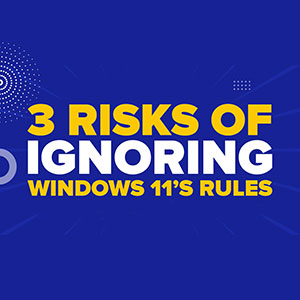
So, you upgraded to Windows 11. You’re excited to try the new design and features, but instead of a smooth experience, your system slows down, crashes, and refuses updates.
That’s what happens when you run Windows 11 on unsupported hardware. Microsoft set strict requirements for a reason—ignoring them can cost your business time, security, and money.
Not sure if your business is at risk? Start with a FREE cybersecurity risk assessment to find out.
Why Windows 11 Requirements Matter for Businesses
Windows 11 isn’t just a facelift—it’s a major upgrade in security, performance, and efficiency. But if your hardware can’t support it, you’re setting yourself up for failure. Microsoft designed Windows 11 with new security features, such as TPM 2.0, a crucial chip that locks away sensitive business data.
Without the right hardware, you lose access to critical security updates and features that protect against cyber threats. And in today’s landscape, that’s a risk no business can afford.
The 3 Biggest Risks of Ignoring Windows 11’s Requirements
Skipping over Windows 11’s hardware rules might seem harmless—until your system starts causing problems. Here’s what happens when businesses cut corners on upgrades:
1. No More Security Updates
Microsoft is pulling the plug on Windows 10 support in October 2025. That means no more security patches, leaving your business exposed to cyber threats. Attackers specifically target outdated systems because they know vulnerabilities won’t be fixed.
If you think you can keep running Windows 10 forever, think again. Hackers will exploit unpatched systems, putting your data, finances, and reputation at risk.
Not ready for Windows 11? Check out your upgrade options before support ends.
2. Your System Will Slow to a Crawl
Windows 11 is designed for modern hardware, faster processors, and advanced security chips. Running it on outdated systems can cause crashes, performance issues, and software incompatibility.
If your business relies on multiple applications, slowdowns will affect productivity, increase downtime, and frustrate employees. That’s not the kind of “upgrade” you want.
3. Compatibility Issues with Business Tools
Many software vendors are moving away from supporting Windows 10 in favor of Windows 11. That means the programs you rely on could stop working properly, forcing you into an upgrade anyway.
Even built-in Windows tools, like Windows Hello, are seeing major improvements that won’t be available on older systems. Check out the latest Windows Hello updates that businesses are already using.
If you rely on quick and easy account switching, Windows is also improving how users sign out. Make logging out seamless with Microsoft’s latest update.
Is It Time to Upgrade? Here’s What to Do Next
If your hardware doesn’t meet Windows 11’s requirements, it’s time to plan your next steps. Waiting until your system slows down—or worse, gets hacked—will only cause bigger problems.
Want an easy transition? Our team can help you upgrade without the stress. Get in touch today and make sure your business is ready for the future.




